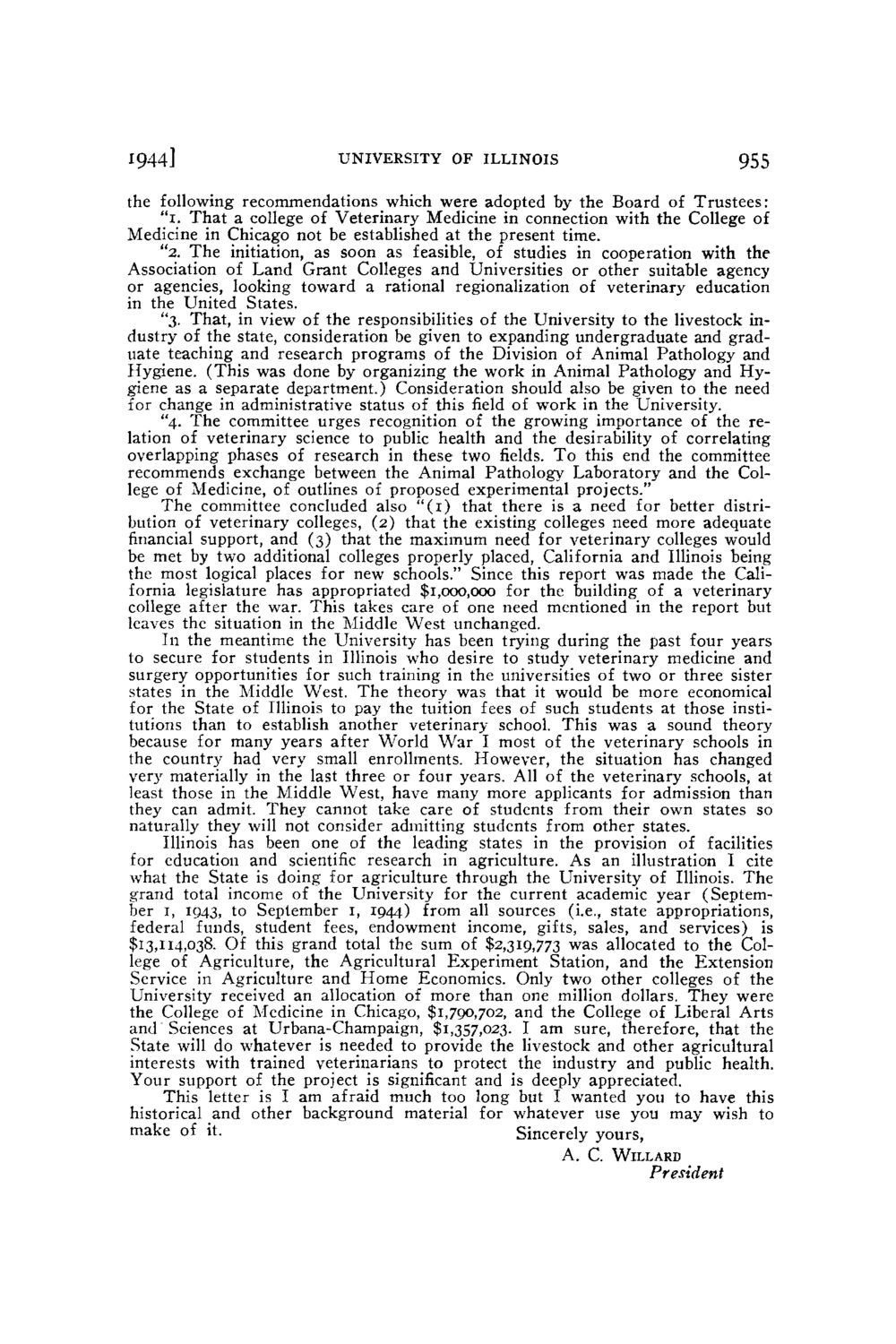| |
| |
Caption: Board of Trustees Minutes - 1944
This is a reduced-resolution page image for fast online browsing.

EXTRACTED TEXT FROM PAGE:
1944] UNIVERSITY OF ILLINOIS 955 the following recommendations which were adopted by the Board of Trustees: " i . T h a t a college of Veterinary Medicine in connection with the College of Medicine in Chicago not be established at the present time. "2. The initiation, as soon as feasible, of studies in cooperation with the Association of Land Grant Colleges and Universities or other suitable agency or agencies, looking toward a rational regionalization of veterinary education in the United States. "3. That, in view of the responsibilities of the University to the livestock industry of the state, consideration be given to expanding undergraduate and graduate teaching and research programs of the Division of Animal Pathology and Hygiene. (This was done by organizing the work in Animal Pathology and Hygiene as a separate department.) Consideration should also be given to the need for change in administrative status of this field of work in the University. "4. The committee urges recognition of the growing importance of the relation of veterinary science to public health and the desirability of correlating overlapping phases of research in these two fields. T o this end the committee recommends exchange between the Animal Pathology Laboratory and the College of Medicine, of outlines of proposed experimental projects." T h e committee concluded also " ( 1 ) that there is a need for better distribution of veterinary colleges, (2) that the existing colleges need more adequate financial support, and (3) that the maximum need for veterinary colleges would be met by two additional colleges properly placed, California and Illinois being the most logical places for new schools." Since this report was made the California legislature has appropriated $1,000,000 for the building of a veterinary college after the war. This takes care of one need mentioned in the report but leaves the situation in the Middle West unchanged. In the meantime the University has been trying during the past four years to secure for students in Illinois who desire to study veterinary medicine and surgery opportunities for such training in the universities of two or three sister states in the Middle West. The theory was that it would be more economical for the State of Illinois to pay the tuition fees of such students at those institutions than to establish another veterinary school. This was a sound theory because for many years after World W a r I most of the veterinary schools in the c o u n t y had very small enrollments. However, the situation has changed v e o ' materially in the last three or four years. All of the veterinary schools, at least those in the Middle West, have many more applicants for admission than they can admit. They cannot take care of students from their own states so naturally they will not consider admitting students from other states. Illinois has been one of the leading states in the provision of facilities for education and scientific research in agriculture. As an illustration I cite what the State is doing for agriculture through the University of Illinois. The grand total income of the University for the current academic year (September 1, 1943, to September 1, 1944) from all sources (i.e., state appropriations, federal funds, student fees, endowment income, gifts, sales, and services) is $13,114,038. Of this grand total the sum of $2,319,773 was allocated to the College of Agriculture, the Agricultural Experiment Station, and the Extension Service in Agriculture and Home Economics. Only two other colleges of the University received an allocation of more than one million dollars. They were the College of Medicine in Chicago, $1,700,702, and the College of Liberal Arts and Sciences at Urbana-Champaign, $1,357,023. I am sure, therefore, that the State will do whatever is needed to provide the livestock and other agricultural interests with trained veterinarians to protect the industry and public health. Your support of the project is significant and is deeply appreciated. This letter is I am afraid much too long but I wanted you to have this historical and other background material for whatever use you may wish to make of it. Sincerely yours, A. C. WlIXARD President
| |